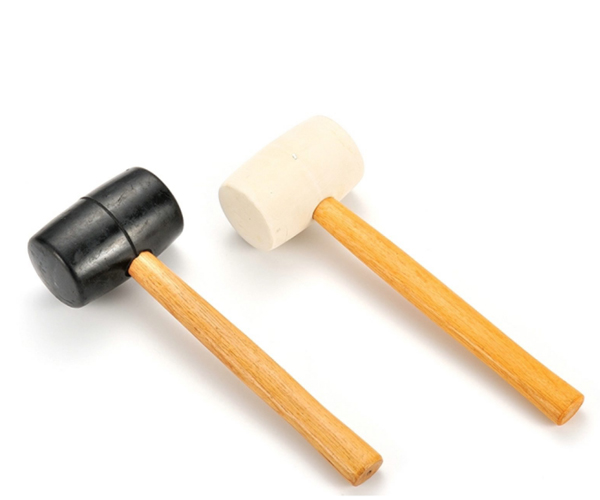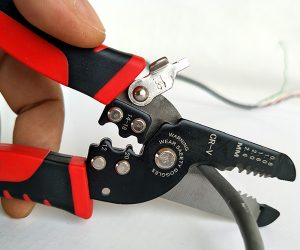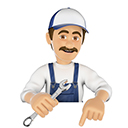A rubber mallet is a versatile tool widely used in various industries. Whether you’re a DIY enthusiast, professional carpenter, or someone working on home repairs, understanding its applications is essential. In this article, we will explore the different uses of a rubber mallet, from woodworking to automotive repairs and more. We’ll break down the key applications and benefits of this tool, highlighting why it is an indispensable part of many toolboxes. Ready for the good part? Let’s dive into how this simple tool can make a big impact.
1. What is a Rubber Mallet and What is It Used For?
A rubber mallet is a type of hammer with a soft rubber head that allows for tapping objects without causing damage. It is commonly used in situations where a regular metal hammer might cause dents, scratches, or marks. This is particularly useful in delicate tasks like assembling furniture or installing tiles.
What’s the real story behind the rubber mallet? Unlike traditional hammers, which have a metal head, the rubber mallet’s head is made from soft yet durable rubber. This provides a gentle but firm strike, making it ideal for tasks requiring precision. For example, when assembling wooden furniture, a rubber mallet ensures that joints are tightly fit without damaging the surface of the wood. Similarly, when working with soft materials like plastic or tiles, a rubber mallet is the perfect tool to prevent cracks or chips.
Rubber mallets also come in handy when you need to tap items into place without the risk of them slipping or misaligning. Whether it’s installing wooden planks, driving pegs into the ground, or gently tapping parts into place, a rubber mallet delivers the right amount of force without causing harm. This makes it an essential tool for many industries, especially when you need both power and protection for sensitive materials.
2. How Does a Rubber Mallet Differ from Other Hammers?
While both rubber mallets and traditional hammers are used for striking, the key difference lies in the material of the head. Traditional hammers typically have a steel head that delivers a more forceful blow, making them better suited for tasks like driving nails or breaking objects apart. However, this can cause damage to the surface of the material being worked on. A rubber mallet, on the other hand, has a soft rubber head, which provides a gentler impact, making it ideal for delicate tasks.
So why choose a rubber mallet over a steel hammer? The answer lies in precision and protection. A rubber mallet allows you to apply consistent force without worrying about leaving marks or causing cracks. For example, when laying tiles, a rubber mallet helps set them into place without damaging the edges. This is crucial when you’re working with fragile materials like glass, tiles, or even some metals.
Moreover, rubber mallets are often used in assembly tasks where precision is key. When putting together pieces of furniture, using a metal hammer could damage the surface, but a rubber mallet ensures that the pieces are fitted together correctly while keeping the material safe from harm. The rubber head also absorbs some of the shock, making it easier on the user’s hands and reducing the risk of injury from vibration.
3. What Are the Common Uses of a Rubber Mallet in DIY Projects?
Rubber mallets are invaluable tools for DIY enthusiasts. Whether you’re working on a small home project or a larger renovation, having the right tools is essential. Here’s where a rubber mallet comes into play. One of the most common DIY uses is when assembling furniture. Using a rubber mallet ensures that pieces fit snugly without causing any damage to the finish. When you’re dealing with wooden dowels or fitting parts together, a gentle tap from a rubber mallet can make all the difference.
But here’s the kicker — rubber mallets are also incredibly useful when working with tiles and flooring. When laying tiles, using a rubber mallet ensures that each tile is placed firmly without breaking or chipping the edges. It’s also a great tool for pushing tiles into grout lines, ensuring a perfect fit. In the same vein, when laying down a wood floor, the rubber mallet helps tap the planks into place without damaging the surface of the wood.
Another great DIY application is in landscaping. Whether you’re driving garden stakes into the ground or positioning outdoor furniture, a rubber mallet ensures that you don’t damage the material while achieving the right placement. The soft yet firm impact of the rubber head prevents any surface damage while still providing the force needed for proper alignment. Whether it’s a small DIY project or a larger home renovation, the rubber mallet proves to be an essential tool for every toolbox.
4. How Is a Rubber Mallet Useful in Car Repairs?
Car repairs often require delicate tasks, where a rubber mallet can play a crucial role. Whether you’re working on a body panel, bumpers, or delicate trim, using a rubber mallet ensures that you don’t damage the parts you’re working on. When trying to align car parts or tap them into place, a rubber mallet delivers the right amount of force without denting or scratching the surface.
What’s the real advantage of using a rubber mallet in automotive repairs? First, it’s all about the protection. Unlike a steel hammer, which could leave noticeable marks on your car’s exterior, a rubber mallet allows you to tap parts into place gently. For instance, when replacing bumpers or attaching body panels, a rubber mallet provides precise, controlled taps that ensure the part fits securely without causing damage. It also prevents the risk of warping metal parts, especially when you need to make adjustments.
Additionally, rubber mallets are helpful when working with materials like plastic or soft metals. If you need to adjust the positioning of soft plastic parts or rubber seals, a rubber mallet ensures that you don’t crack or break them while still achieving the desired fit. This makes the rubber mallet an indispensable tool for car repairs and maintenance.
5. Can a Rubber Mallet Be Used in Woodworking?
Rubber mallets are a staple in woodworking, especially when you need a soft touch combined with firm pressure. One of the most common uses is when fitting joints together. Whether you’re assembling furniture or installing cabinetry, using a rubber mallet prevents any damage to the wood while still allowing you to apply the necessary force to get a tight fit. Without the risk of denting or scratching the surface, a rubber mallet makes woodworking projects more efficient and precise.
So how does a rubber mallet protect your wood while still being effective? The soft rubber head allows for a firm strike without leaving any impressions or marks on the material. This is especially useful when working with softwoods like pine, where the surface can easily be damaged by a steel hammer. Moreover, when working with carving or shaping tools, a rubber mallet can be used to gently tap chisels into place, ensuring that the tool remains sharp and doesn’t get damaged during use.
The versatility of a rubber mallet in woodworking extends to tasks like assembling wooden frames or driving dowels into pre-drilled holes. It ensures that the pieces fit snugly without causing any harm to the wood’s surface. With a rubber mallet in hand, you can confidently complete your woodworking projects with precision and ease.
6. Why Do Professionals Prefer Rubber Mallets for Tiling?
Professionals in the tiling industry often prefer rubber mallets for one simple reason: precision. When working with tiles, it’s essential to apply just the right amount of pressure to avoid cracking or chipping the edges. A rubber mallet allows for a controlled impact that ensures tiles are properly aligned without damaging the surface. Ready for the good part? Rubber mallets also help set the tiles evenly, ensuring that grout lines are uniform and the installation process goes smoothly.
Moreover, using a rubber mallet makes it easier to achieve a tight fit when laying tiles. Whether it’s a floor or a wall project, a rubber mallet ensures that the tiles are placed firmly into position without disturbing the rest of the layout. It’s especially useful when adjusting tiles after initial placement to make sure there are no gaps or misalignments. This makes rubber mallets indispensable tools for tiling professionals.
The advantage of using a rubber mallet in tiling doesn’t just stop with placement. It’s also effective when tapping grout lines to ensure that the grout settles into the gaps without damaging the tiles. This ensures a clean, seamless finish every time. For these reasons, rubber mallets are a go-to tool for any professional tiler.
7. Is a Rubber Mallet Useful for Framing?
When it comes to framing, precision is crucial, and a rubber mallet plays a pivotal role in ensuring accuracy without causing any damage to the materials. Framing often involves driving pieces of wood together, and the last thing you want is to leave marks or dents on the surface. A rubber mallet offers the perfect solution here. It allows for firm, controlled taps to ensure pieces fit snugly together without damaging the wood.
So, why do framers choose rubber mallets? The answer lies in its ability to provide force without the risk of harming the material. For example, when installing drywall or securing framing beams, a rubber mallet delivers just the right amount of impact to get the pieces in place. Without worrying about leaving marks, the framing process becomes much smoother, and the result is more professional.
Moreover, rubber mallets are especially beneficial when it comes to adjusting the alignment of framed structures. If you’re working on a project like installing studs or beams, a rubber mallet ensures everything stays aligned while also providing control over the entire process. The flexibility and precision provided by a rubber mallet make it a must-have tool for framers.
8. How Does a Rubber Mallet Help in Metalworking?
In metalworking, precision is just as important as in woodworking or tiling, but the materials being worked on are often much harder. Rubber mallets are essential in metalworking for tasks that involve shaping, bending, or tapping metal parts into place. Unlike metal hammers, which can leave dents and marks on the surface of metals, rubber mallets ensure that the metal remains smooth and undamaged while still allowing you to apply necessary force.
What’s the real benefit here? Rubber mallets absorb much of the impact, which helps prevent the kind of damage that can occur with a steel hammer. For example, when shaping sheet metal or tapping rivets into place, a rubber mallet provides the perfect balance between impact and protection. Whether you’re working with aluminum, brass, or other metals, a rubber mallet gives you the confidence that your metalwork will be flawless without any unwanted damage.
Rubber mallets are also used in metalworking when you need to adjust or align parts without causing any distortion. This is particularly useful when dealing with fragile or precision metal components. By using a rubber mallet, you can work more efficiently, knowing that you’re protecting the integrity of your materials.
9. Can a Rubber Mallet Be Used in Gardening or Landscaping?
Gardening and landscaping require tools that can help with precision while ensuring that delicate materials, like plants, aren’t damaged. A rubber mallet is perfect for this. Whether you’re driving garden stakes into the ground, tapping edging into place, or positioning large rocks, a rubber mallet ensures that the force applied is gentle enough not to harm the plants or surfaces.
What’s the real story here? When installing garden borders or laying down heavy stones for walkways, a rubber mallet provides a controlled force that helps ensure everything is in place. Without damaging delicate plants or cracking stones, a rubber mallet makes the job easier. It’s especially useful when working with more fragile materials like limestone or decorative rocks.
Another great use for a rubber mallet in landscaping is when installing fencing or tapping posts into position. A rubber mallet allows you to strike the posts firmly into the ground without risking damage to the surrounding area or the post itself. It’s a tool that helps to keep your landscaping projects safe and precise.
10. What Are the Different Types of Rubber Mallets Available?
Rubber mallets come in various types, each designed for specific applications. When choosing a rubber mallet, it’s essential to consider the task at hand. Rubber mallets are generally divided into two main categories: soft rubber mallets and hard rubber mallets. Soft rubber mallets are ideal for delicate tasks, such as working with tiles or woodworking, where you want to avoid causing damage to the material. Hard rubber mallets are better suited for tasks that require more force, like metalworking or driving stakes into the ground.
But here’s the kicker — it’s not just about the hardness of the rubber. The handle material and length are also important factors to consider. Some rubber mallets come with wooden handles, while others feature fiberglass or plastic handles. Wooden handles provide a more traditional feel and are often preferred by those who want a more classic tool. On the other hand, fiberglass and plastic handles offer more durability and are resistant to breaking under pressure.
Additionally, rubber mallets vary in size. Some are small and lightweight, making them perfect for tasks like jewelry making or delicate tiling work. Others are larger and heavier, ideal for tasks like landscaping or automotive repairs where more force is needed. Choosing the right size ensures that you’ll be able to complete your task efficiently without overexerting yourself or risking injury.
11. How Do I Maintain and Care for My Rubber Mallet?
Proper maintenance is key to ensuring the longevity and effectiveness of your rubber mallet. While rubber mallets are durable, they require care to ensure they continue performing well. One of the easiest ways to maintain a rubber mallet is to clean it after every use. Use a damp cloth to wipe down the head and handle, removing any dirt, debris, or residue that may have accumulated during the task.
What’s the real benefit of cleaning your rubber mallet? By keeping the mallet clean, you prevent build-up from interfering with its performance. Additionally, cleaning ensures that no materials stick to the rubber head, which could cause damage when working with sensitive surfaces.
Another important aspect of rubber mallet maintenance is proper storage. Avoid leaving your rubber mallet in direct sunlight or storing it in damp environments, as prolonged exposure to these conditions can cause the rubber to degrade. Storing your mallet in a cool, dry place will help preserve its integrity and ensure it’s ready for use when you need it.
12. What Are the Safety Considerations When Using a Rubber Mallet?
While rubber mallets are generally safer than metal hammers, safety should still be a priority when using any tool. The first safety consideration is to make sure you’re using the rubber mallet for the right task. Using a rubber mallet for jobs that require more force, like demolition, could lead to injury or tool failure. So, always use the right tool for the job.
Moreover, it’s essential to grip the handle correctly to avoid slipping or mishandling the mallet. A proper grip ensures that you can control the mallet effectively, reducing the risk of injury. It’s also crucial to wear safety goggles when working with tools, even those as harmless as rubber mallets. This will protect your eyes from debris or accidental strikes.
When using a rubber mallet, always aim at the object you’re tapping, ensuring you have a clear line of sight and a stable surface. Striking a moving object or an unstable surface can result in accidents. Finally, make sure the area around you is clear of obstacles that could interfere with your work. A safe and controlled work environment is essential for preventing accidents.
13. Are There Any Limitations to Using a Rubber Mallet?
While rubber mallets are incredibly versatile, they do have their limitations. For example, rubber mallets are not suitable for heavy-duty tasks that require a lot of impact force. If you need to break through concrete or demolish a wall, a rubber mallet will not be sufficient. In these cases, a steel hammer or another more powerful tool is necessary.
Another limitation is that rubber mallets may wear out over time, especially if they are used for tasks that require repetitive striking or if the rubber head comes into contact with hard surfaces. The material can begin to degrade, losing its effectiveness. It’s important to replace your rubber mallet when you notice signs of wear to maintain optimal performance.
Rubber mallets also have limited versatility when it comes to tasks requiring pinpoint accuracy, such as fine metalwork. In these cases, a smaller tool like a tack hammer may be more appropriate. However, for the vast majority of tasks, rubber mallets are an essential tool that can provide the right balance of force and protection.
14. How Can a Rubber Mallet Be Used in Crafts and Art Projects?
Rubber mallets are not only useful for practical tasks but also play an important role in creative projects like crafts and art. Artists and craftsmen use rubber mallets when working with delicate materials like clay, leather, and metal. The soft impact helps shape materials without distorting or damaging them.
What’s the real advantage here? Rubber mallets allow artists to gently tap and shape their creations without fear of breaking or marring the surface. For example, in jewelry making, a rubber mallet is used to shape metal or set stones into place without leaving any marks. Similarly, in leatherworking, a rubber mallet ensures that seams are stitched evenly without damaging the leather.
Rubber mallets are also great for sculpting. Whether you’re working with clay, wood, or soft metals, the controlled impact of a rubber mallet allows you to refine your craft with precision and care. It’s an indispensable tool for artists who need to maintain the integrity of their materials while still being able to shape them with force.
15. What Are the Benefits of Owning a Rubber Mallet?
There are several benefits to owning a rubber mallet. First, it’s an incredibly versatile tool that can be used in a wide range of industries and hobbies. Whether you’re a DIY enthusiast, a professional in woodworking or automotive repair, or someone who enjoys crafting, a rubber mallet is a must-have tool.
What’s the real value here? A rubber mallet provides the ability to apply force without causing damage to surfaces, making it perfect for delicate tasks. It’s also relatively inexpensive and can last for years if properly maintained. Having a rubber mallet on hand ensures that you can tackle a variety of tasks with confidence and precision.
Additionally, a rubber mallet helps you avoid injuries that can come from using harder hammers. The shock-absorbing properties of the rubber head reduce the impact on your hands and wrists, making it a more ergonomic option. This can be a significant advantage for professionals who use tools regularly and need to reduce strain.
FAQ
Q1: What is a rubber mallet used for?
A rubber mallet is used for tasks requiring a softer impact than a traditional hammer, such as assembling furniture, working with delicate materials like tiles or wood, and in car repairs.
Q2: How does a rubber mallet differ from other hammers?
A rubber mallet has a soft rubber head, providing a gentler impact, while traditional hammers have metal heads that can cause damage to delicate surfaces.
Q3: Can a rubber mallet be used for woodworking?
Yes, rubber mallets are ideal for woodworking, as they allow for precise tapping without damaging the wood’s surface or finish.
Q4: Why do professionals prefer rubber mallets for tiling?
Professionals prefer rubber mallets for tiling because they offer controlled, gentle strikes that ensure the tiles are properly aligned without damaging the edges.
Q5: How should I maintain my rubber mallet?
To maintain your rubber mallet, clean it regularly, store it properly in a dry place, and avoid using it on extremely hard surfaces to preserve the integrity of the rubber head.





